Spatio-Temporal Patterns of Livestock Predation by Leopards in Bardia National Park, Nepal
Abstract
1. Introduction
2. Materials and Methods
2.1. Study Area
2.2. Data Collection and Analysis
3. Results
3.1. Spatial Analysis
3.2. Temporal Analysis
3.3. Prey Predated
3.4. Livestock Depredation Trend
3.5. Compensation Trend
4. Discussion
5. Conclusions
Author Contributions
Funding
Institutional Review Board Statement
Informed Consent Statement
Data Availability Statement
Acknowledgments
Conflicts of Interest
References
- Nyhus, P.J. Human-Wildlife Conflict and Coexistence. Ann. Rev. Env Res. 2016, 41, 141–173. [Google Scholar] [CrossRef]
- Mekonen, S. Coexistence between human and wildlife: The nature, causes and mitigations of human wildlife conflict around Bale Mountains National Park, Southeast Ethiopia. BMC Ecol. 2020, 20, 51. [Google Scholar] [CrossRef]
- Seoraj-Pillai, N.; Pillay, N. A meta-analysis of human-wildlife conflict: South African and global perspectives. Sustainability 2017, 9, 34. [Google Scholar] [CrossRef]
- Acharya, K.P.; Paudel, P.K.; Neupane, P.R.; Köhl, M. Human-wildlife conflicts in Nepal: Patterns of human fatalities and injuries caused by large mammals. PLoS ONE 2016, 11, 9. [Google Scholar] [CrossRef]
- Torres, D.F.; Oliveira, E.S.; Alves, R.R.N. Understanding Human-Wildlife Conflicts and Their Implications. Ethnozoology 2018, 421–445. [Google Scholar] [CrossRef]
- Wegge, P.; Yadav, S.K.; Lamichhane, B.R. Are corridors good for tigers Panthera tigris but bad for people? An assessment of the Khata corridor in lowland Nepal. Oryx 2018, 52, 35–45. [Google Scholar] [CrossRef]
- Silwal, T.; Kolejka, J.; Bhatta, B.P.; Rayamajhi, S.; Sharma, R.P.; Poudel, B.S. When, where and whom: Assessing wildlife attacks on people in Chitwan National Park, Nepal. Oryx 2017, 51, 370–377. [Google Scholar] [CrossRef]
- Long, Z.; Gu, J.; Jiang, G.; Holyoak, M.; Wang, G.; Bao, H.; Liu, P.; Zhang, M.; Ma, J. Spatial conservation prioritization for the Amur tiger in Northeast China. Ecosphere 2021, 12, 9. [Google Scholar] [CrossRef]
- Bauer, H.; Dickman, A.; Chapron, G.; Oriol-Cotterill, A.; Nicholson, S.K.; Sillero-Zubiri, C.; Hunter, L.; Lindsey, P.; Macdonald, D.W. Threat analysis for more effective lion conservation. Oryx 2022, 56, 108–115. [Google Scholar] [CrossRef]
- Everatt, K.T.; Moore, J.F.; Kerley, G.I.H. Africa’s apex predator, the lion, is limited by interference and exploitative competition with humans. Glob. Ecol. Conserv. 2019, 20, e00758. [Google Scholar] [CrossRef]
- Donnelly, A. A Comparative Analysis of Felid Conservation Strategies on four Continents: Can one Size Fit All. BSc Thesis, Roanoke College, Salem, VA, USA, 2020. [Google Scholar]
- Nanni, A.S.; Teel, T.; Lucherini, M. Predation on livestock and its influence on tolerance toward pumas in agroecosystems of the Argentine Dry Chaco. Hum. Dimens. Wildl. 2020, 26, 429–444. [Google Scholar] [CrossRef]
- Viollaz, J.S.; Thompson, S.T.; Petrossian, G.A. When human–wildlife conflict turns deadly: Comparing the situational factors that drive retaliatory leopard killings in South Africa. Animals 2021, 11, 3281. [Google Scholar] [CrossRef]
- Soofi, M.; Qashqaei, A.T.; Mousavi, M.; Hadipour, E.; Filla, M.; Kiabi, B.H.; Bleyhl, B.; Ghoddousi, A.; Balkenhol, N.; Royle, A.; et al. Quantifying the relationship between prey density, livestock and illegal killing of leopards. J. Appl. Ecol. 2022, 59, 1536–1547. [Google Scholar] [CrossRef]
- Aryal, C.; Pokharel, M. Assessment of Human-Wildlife Conflict and Its Implication for Conservation at Sundarpur, Udayapur, Eastern Nepal. Tribhuvan Univ. J. 2019, 33, 15–30. [Google Scholar] [CrossRef]
- Baral, K.; Sharma, H.P.; Kunwar, R.; Morley, C.; Aryal, A.; Rimal, B.; Ji, W. Human wildlife conflict and impacts on livelihood: A study in community forestry system in mid-hills of Nepal. Sustainability 2021, 13, 13170. [Google Scholar] [CrossRef]
- Jha, D.K. The Role of Livestock in Rural Households in Nepal. Int. J. Publ. Soc. Stud. 2019, 4, 67–91. [Google Scholar] [CrossRef]
- Sharma, P.; Chettri, N.; Wangchuk, K. Human–wildlife conflict in the roof of the world: Understanding multidimensional perspectives through a systematic review. Ecol. Evol. 2021, 11, 11569–11586. [Google Scholar] [CrossRef]
- Sijapati, R.; Sharma, H.; Sharma, S.; Subedi, J.; Belant, J. Livestock depredation by leopards and tigers near Bardia national park, nepal. Animals 2021, 11, 1896. [Google Scholar] [CrossRef]
- Tamang, B.; Baral, N. Livestock depredation by large cats in Bardia National Park, Nepal: Implications for improving park-people relations. Int. J. Biodivers. Sci. Manag. 2008, 4, 44–53. [Google Scholar] [CrossRef]
- Dhungana, R.; Lamichhane, B.R.; Savini, T.; Dhakal, M.; Poudel, B.S.; Karki, J.B. Livestock depredation by leopards around Chitwan National Park, Nepal. Mamm. Biol. 2019, 96, 7–13. [Google Scholar] [CrossRef]
- Dhungana, R.; Savini, T.; Karki, J.B.; Dhakal, M.; Lamichhane, B.R.; Bumrungsri, S. Living with tigers Panthera tigris: Patterns, correlates, and contexts of human-tiger conflict in Chitwan National Park, Nepal. Oryx 2018, 52, 55–65. [Google Scholar] [CrossRef]
- Lesilau, F.; Fonck, M.; Gatta, M.; Musyoki, C.; Zelfde, M.V.; Persoon, G.A.; Musters, K.C.J.M.; De Snoo, G.R.; De Iongh, H.H. Effectiveness of a LED flashlight technique in reducing livestock depredation by lions (Panthera leo) around Nairobi National Park, Kenya. PLoS ONE 2018, 13, e0190898. [Google Scholar] [CrossRef] [PubMed]
- Soofi, M.; Ghoddousi, A.; Zeppenfeld, T.; Shokri, S.; Soufi, M.; Egli, L.; Jafari, A.; Ahmadpour, M.; Qashqaei, A.; Ghadirian, T.; et al. Assessing the relationship between illegal hunting of ungulates, wild prey occurrence and livestock depredation rate by large carnivores. J. Appl. Ecol. 2019, 56, 365–374. [Google Scholar] [CrossRef]
- Ramesh, T.; Kalle, R.; Milda, D.; Gayathri, V.; Thanikodi, M.; Ashish, K.; Giordano, A.J. Patterns of livestock predation risk by large carnivores in India’s Eastern and Western Ghats. Glob. Ecol. Conserv. 2020, 24, e01366. [Google Scholar] [CrossRef]
- Mijiddorj, T.N.; Alexander, J.S.; Samelius, G.; Badola, R.; Rawat, G.S.; Dutta, S. Livestock depredation by large carnivores in the South Gobi, Mongolia. Wildl. Res. 2018, 45, 237–246. [Google Scholar] [CrossRef]
- LeFlore, E.G.; Fuller, T.K.; Tomeletso, M.; Stein, A.B. Livestock depredation by large carnivores in northern Botswana. Glob. Ecol. Conserv. 2019, 18, e00592. [Google Scholar] [CrossRef]
- Chaka, S.N.M.; Kissui, B.M.; Gray, S.; Montgomery, R.A. Predicting the fine-scale factors that correlate with multiple carnivore depredation of livestock in their enclosures. Afr. J. Ecol. 2020, 59, 74–87. [Google Scholar] [CrossRef]
- Kuiper, T.; Loveridge, A.J.; Macdonald, D.W. Robust mapping of human–wildlife conflict: Controlling for livestock distribution in carnivore depredation models. Anim. Conserv. 2021, 25, 195–207. [Google Scholar] [CrossRef]
- Kissui, B.M.; Kiffner, C.; Köni, H.J.; Montgomery, R.A. Patterns of livestock depredation and cost-effectiveness of fortified livestock enclosures in northern Tanzania. Ecol. E 2019, 9, 11420–11433. [Google Scholar] [CrossRef]
- Khorozyan, I.; Waltert, M. A global view on evidence-based effectiveness of interventions used to protect livestock from wild cats. Conserv. Sci. Pract. 2021, 3, e317. [Google Scholar] [CrossRef]
- Bista, A.; Chanchani, P.; Subedi, N.; Bajracharya, S.B. The peri-urban leopards of Kathmandu: Assessing determinants of presence and predation on domestic animals. Oryx 2022, 56, 91–100. [Google Scholar] [CrossRef]
- Adhikari, B.; Odden, M.; Adhikari, B.; Panthi, S.; López-Bao, J.V.; Low, M. Livestock husbandry practices and herd composition influence leopard-human conflict in Pokhara Valley, Nepal. Hum. Dimens. Wildl. 2019, 25, 62–69. [Google Scholar] [CrossRef]
- Consolee, K.T.; Gao, C.; Vitekere, K.; Li, C.; Yan, H.; Jiang, G. Human-leopard conflict: An emerging issue of North China leopard conservation in Tieqiaoshan provincial nature reserve in Shanxi Province, China. Animals 2020, 10, 996. [Google Scholar] [CrossRef] [PubMed]
- BNP. Management Plan of Bardia National Park and its Buffer Zone (2079/80-2083/84); Bardia National Park: Bardiya, Nepal, 2022. [Google Scholar]
- Kunwar, A.; Koju, N.P. Prey Diversity of Common Leopard and Factors Affecting Human-Common Leopard Conflict in Community Forests of Arghakhanchi District Nepal. J. Adv. Acad. Res. 2019, 6, 84–100. [Google Scholar] [CrossRef]
- Inskip, C.; Zimmermann, A. Human-felid conflict: A review of patterns and priorities worldwide. Oryx 2009, 43, 18–34. [Google Scholar] [CrossRef]
- Redpath, S.M.; Young, J.; Evely, A.; Adams, W.M.; Sutherland, W.J.; Whitehouse, A.; Amar, A.; Lambert, R.A.; Linnell, J.D.; Watt, A.; et al. Understanding and managing conservation conflicts. Trends Ecol. Evol. 2013, 28, 100–109. [Google Scholar] [CrossRef]
- Lamichhane, B.R.; Persoon, G.A.; Leirs, H.; Poudel, S.; Subedi, N.; Pokheral, C.P.; Bhattarai, S.; Gotame, P.; Mishra, R.; de Iongh, H.H. Contribution of Buffer Zone Programs to Reduce Human-Wildlife Impacts: The Case of the Chitwan National Park, Nepal. Hum. Ecol. 2019, 47, 95–110. [Google Scholar] [CrossRef]
- Shahi, K.; Khanal, G.; Jha, R.R.; Joshi, A.K.; Bhusal, P.; Silwal, T. Characterizing damages caused by wildlife: Learning from Bardia National Park, Nepal. Hum. Dimens. Wildl. 2021, 27, 173–182. [Google Scholar] [CrossRef]
- Upadhyay, S.K. Human-wildlife Interactions in the Western Terai of Nepal. Doctoral Dissertation, Leiden University, Leiden, The Netherlands, 2019. [Google Scholar]
- Thapa, S.K.; De Jong, J.F.; Hof, A.R.; Subedi, N.; Liefting, Y.; Prins, H.H.T. Integration of the landscape of fear concept in terrain management—An experimental study on deer in Bardia National Park, Nepal. Res. Sq. 2022, 1–16. [Google Scholar] [CrossRef]
- Upadhyaya, S.K. Activity patterns of co-existing tigers and leopards. Doctoral Dissertation, leiden university, Leiden, The Netherlands, 2019. [Google Scholar]
- LeClerq, A.T.; Gore, M.L.; Lopez, M.C.; Kerr, J.M. Local perceptions of conservation objectives in an alternative livelihoods program outside Bardia National Park, Nepal. Conserv. Sci. Pract. 2019, 1, e131. [Google Scholar] [CrossRef]
- Thapa, S.K.; de Jong, J.F.; Subedi, N.; Hof, A.R.; Corradini, G.; Basnet, S.; Prins, H.H. Forage quality in grazing lawns and tall grasslands in the subtropical region of Nepal and implications for wild herbivores. Glob. Ecol. Conserv. 2021, 30, e01747. [Google Scholar] [CrossRef]
- Lamichhane, B.R.; Persoon, G.A.; Leirs, H.; Poudel, S.; Subedi, N.; Pokheral, C.P.; Bhattarai, S.; Thapaliya, B.P.; De Iongh, H.H. Spatio-temporal patterns of attacks on human and economic losses from wildlife in Chitwan National Park, Nepal. PLoS ONE 2018, 13, e0195373. [Google Scholar] [CrossRef] [PubMed]
- Athreya, V.; Isvaran, K.; Odden, M.; Linnell, J.D.C.; Kshettry, A.; Krishnaswamy, J.; Karanth, U.K. The impact of leopards (Panthera pardus ) on livestock losses and human injuries in a human-use landscape in Maharashtra, India. PeerJ 2020, 8, e8405. [Google Scholar] [CrossRef] [PubMed]
- Bargali, H.S.; Ahmed, T. Patterns of livestock depredation by tiger (Panthera tigris) and leopard ( Panthera pardus ) in and around Corbett Tiger Reserve. PLoS ONE 2018, 13, e0195612. [Google Scholar] [CrossRef] [PubMed]
- Gurung, B.; Nelson, K.C.; Smith, J.L. Impact of grazing restrictions on livestock composition and husbandry practices in Madi Valley, Chitwan National Park, Nepal. Environ. Conserv. 2010, 36, 338–347. [Google Scholar] [CrossRef]
- Miller, J.R.B.; Jhala, Y.V.; Jena, J. Spatial and temporal patterns of livestock losses and hotspots of attack from tigers and leopards in Kanha Tiger Reserve, central India. Reg. Environ. Chang. 2016, 16 (Suppl. S1), 17–29. [Google Scholar] [CrossRef]
- Dhakal, M.; Karki (Thapa), M.; Jnawali, S.R.; Subedi, N.; Pradhan, N.M.B.; Malla, S.; Lamichhane, B.R.; Pokheral, C.P.; Thapa, G.J.; Oglethorpe, J.; et al. Status of Tigers and Prey in Nepal; Department of National Parks and Wildlife Conservation: Kathmandu, Nepal, 2014. [CrossRef]
- DNPWC and DFSC. Status of Tigers and Prey in Nepal 2022; Department of National Parks and Wildlife Conservation and Department of Forests and Soil Conservation; Ministry of Forests and Environment: Kathmandu, Nepal, 2022.
- Simcharoen, A.; Simcharoen, S.; Duangchantrasiri, S.; Bump, J.; Smith, J.L. Tiger and leopard diets in western Thailand: Evidence for overlap and potential consequences. Food Webs 2018, 15, e00085. [Google Scholar] [CrossRef]
- Odden, M.; Wegge, P.; Fredriksen, T. Do tigers displace leopards? If so, why? Ecol. Res. 2010, 25, 875–881. [Google Scholar] [CrossRef]
- Pokheral, C.P.; Wegge, P. Coexisting large carnivores: Spatial relationships of tigers and leopards and their prey in a prey-rich area in lowland Nepal. Écoscience 2018, 26, 1–9. [Google Scholar] [CrossRef]
- Upadhyaya, S.K.; Musters, C.; Bhandari, A.; Lamichhane, B.; de Snoo, G.; Thapa, P.; Dhakal, M.; de Iongh, H.H. Spatiotemporal Patterns of Human-Wildlife Interactions; Research Article under Doctoral Dissertation at Univ: Leiden, The Netherlands, 2019. [Google Scholar]
- Dar, N.I.; Minhas, R.A.; Zaman, Q.; Linkie, M. Predicting the patterns, perceptions and causes of human—Carnivore conflict in and around Machiara National Park, Pakistan. Biol. Conserv. 2009, 142, 2076–2082. [Google Scholar] [CrossRef]
- Zehra, N.; Chaudhary, R.; Kumar, S.; Khan, J.A. Human-Leopard Interactions Around Gir National Park and Sanctuary, Gujarat, India. Int. J. Ecol. Environ. Sci. 2022, 48, 755–765. [Google Scholar] [CrossRef]
- Naha, D.; Dash, S.K.; Chettri, A.; Chaudhary, P.; Sonker, G.; Heurich, M.; Rawat, G.S.; Sathyakumar, S. Landscape predictors of human–leopard conflicts within multi-use areas of the Himalayan region. Sci. Rep. 2020, 10, 11129. [Google Scholar] [CrossRef] [PubMed]
- Kissui, B.M. Livestock predation by lions, leopards, spotted hyenas, and their vulnerability to retaliatory killing in the Maasai steppe, Tanzania. Anim. Conserv. 2008, 11, 422–432. [Google Scholar] [CrossRef]
- Puls, S.; Teichman, K.J.; Jansen, C.; O’Riain, M.J.; Cristescu, B. Activity patterns of leopards (Panthera pardus) and temporal overlap with their prey in an arid depredation hotspot of southern Africa. J. Arid Environ. 2021, 187, 104430. [Google Scholar] [CrossRef]
- Manoa, D.O.; Mwaura, F. Predator-Proof Bomas as a Tool in Mitigating Human-Predator Conflict in Loitokitok Sub-County Amboseli Region of Kenya. Nat. Resour. 2016, 7, 28–39. [Google Scholar] [CrossRef]
- Jafari, A.; Zamani-Ahmadmahmoodi, R.; Mirzaei, R. Persian leopard and wild sheep distribution modeling using the Maxent model in the Tang-e-Sayad protected area, Iran. Mammalia 2018, 83, 84–96. [Google Scholar] [CrossRef]
- WWF Nepal. Annual Report 2007–2008; WWF Nepal: Kathmandu, Nepal, 2008; Available online: https://wwfasia.awsassets.panda.org/downloads/wwf_annual_report_2007_08_2.pdf (accessed on 15 October 2022).
- Nakarmi, G. Evaluation of Protected Areas—A Case Study of Chitwan National Park of Nepal; University of Klagenfut: Klagenfu, Austria, 2007. [Google Scholar]
- Karki, D.; Poudel, N.; Dixit, S.; Bhatta, S.; Gotame, B.; Dhamala, M.K.; Khadka, D. Human-Wildlife Conflicts in Paschim Kusaha Village of Koshi Tappu Wildlife Reserve, Sunsari District, Nepal. J. Resour. Ecol. 2022, 13, 1022–1029. [Google Scholar] [CrossRef]
- Sherchan, R.; Kumar, R.; Roshani, R.; Arun, R. Designing a community—based insurance scheme to reduce human–wildlife conflict. Environ. Dev. Sustain. 2021, 24, 5112–5130. [Google Scholar] [CrossRef]
- Treves, A.; Wallace, R.B.; Naughton-treves, L.; Morales, A. Co-Managing Human–Wildlife Conflicts: A Review. Hum. Dimens. Wildl. 2006, 11, 383–396. [Google Scholar] [CrossRef]
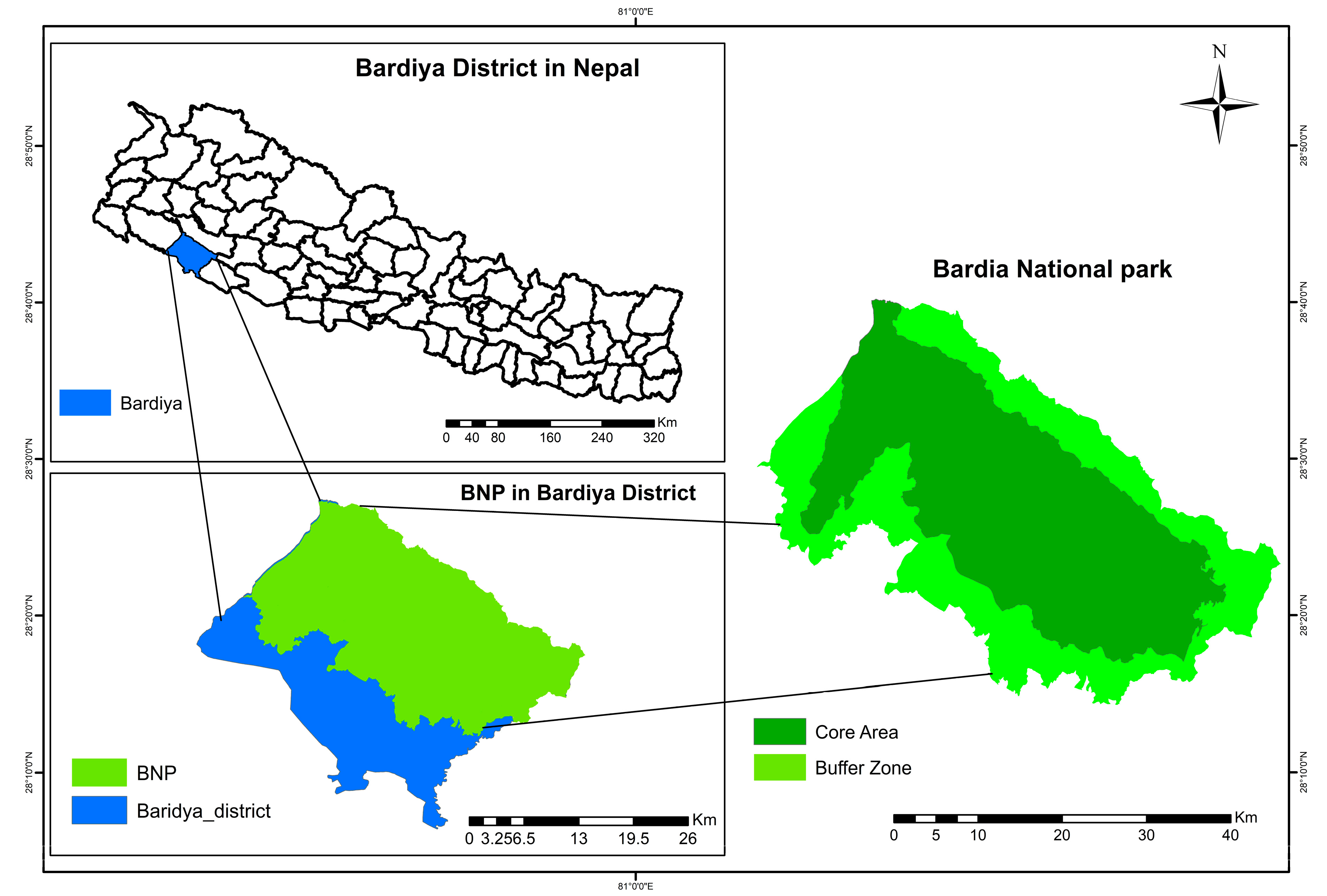
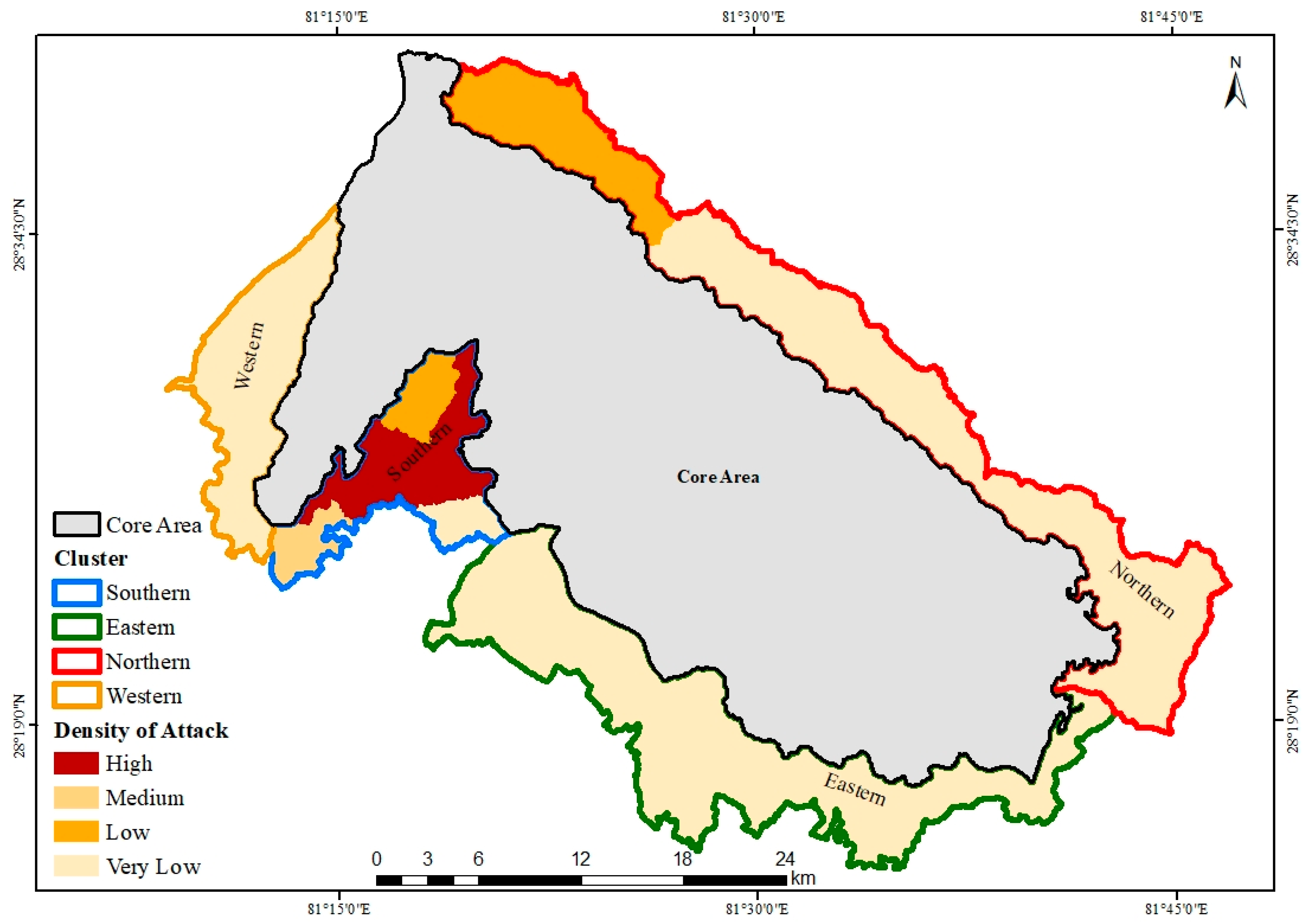
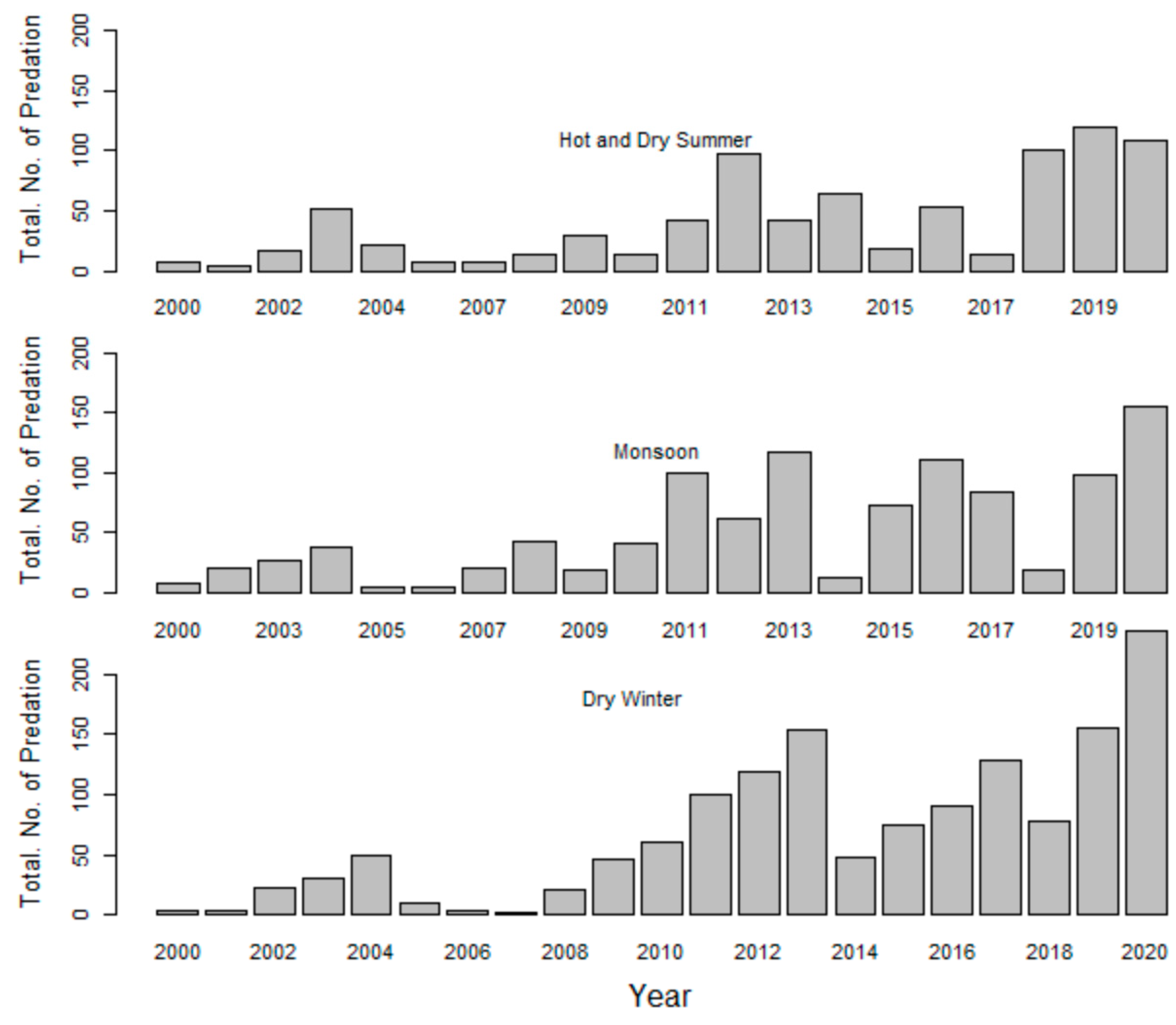
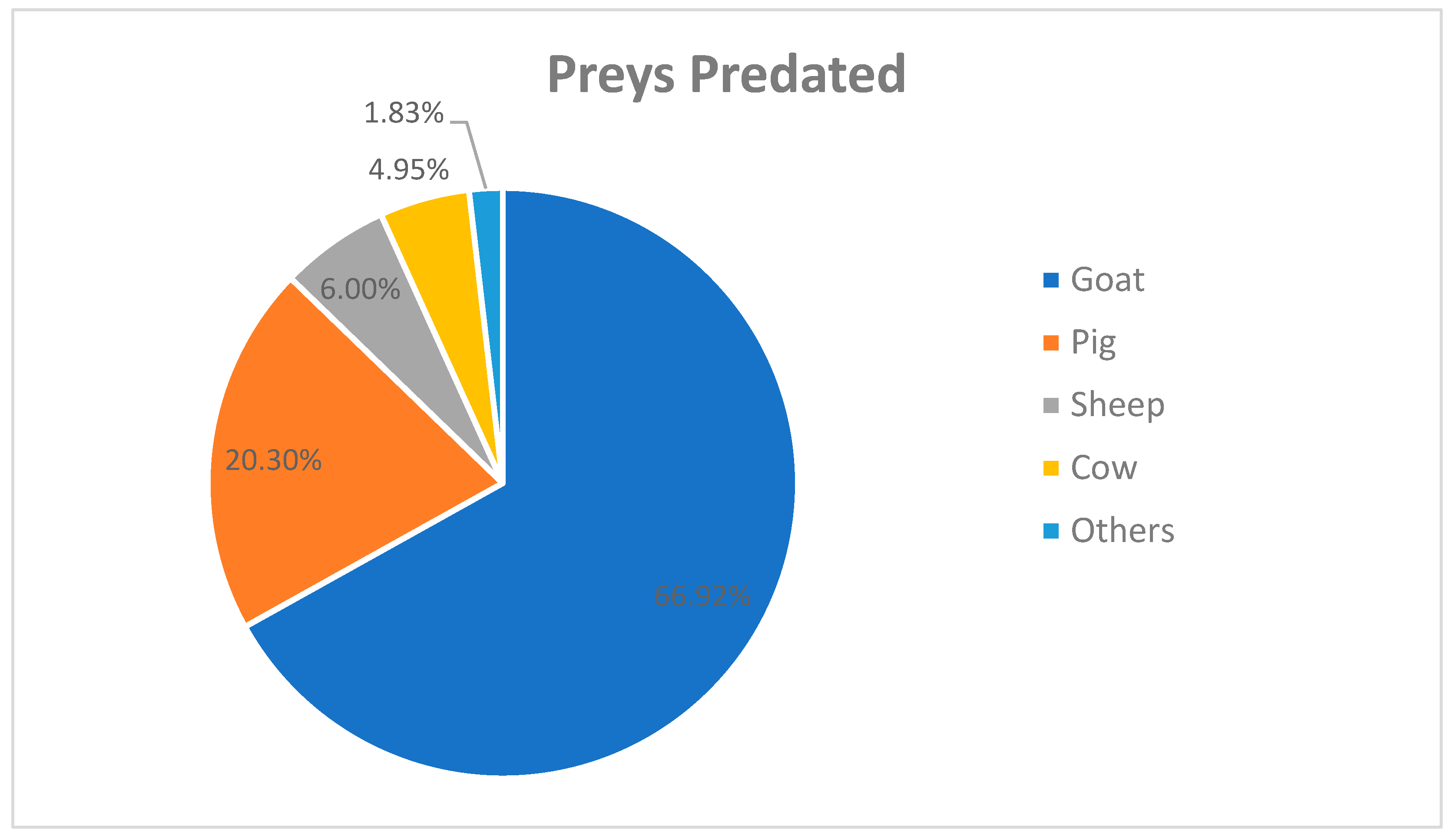
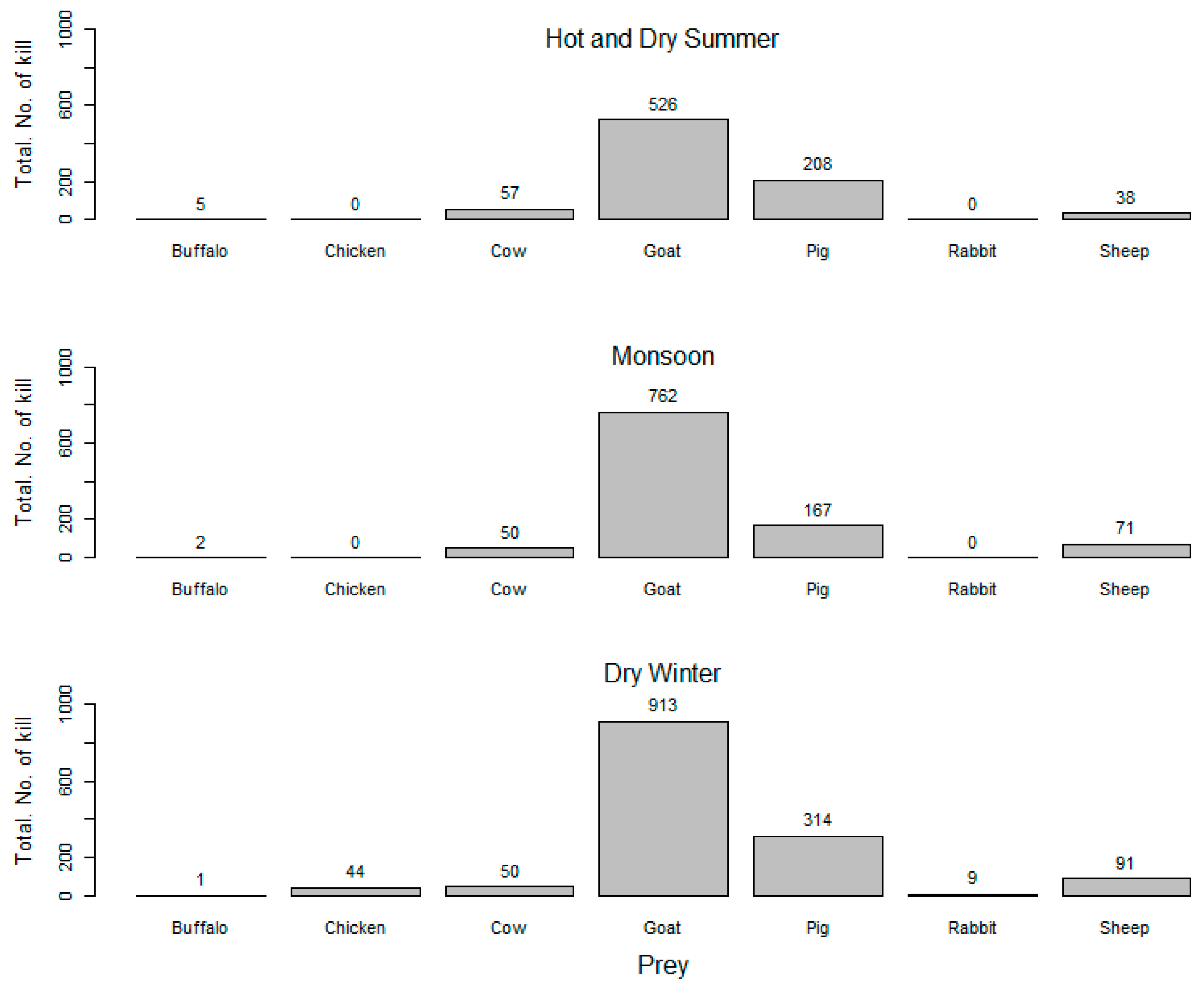
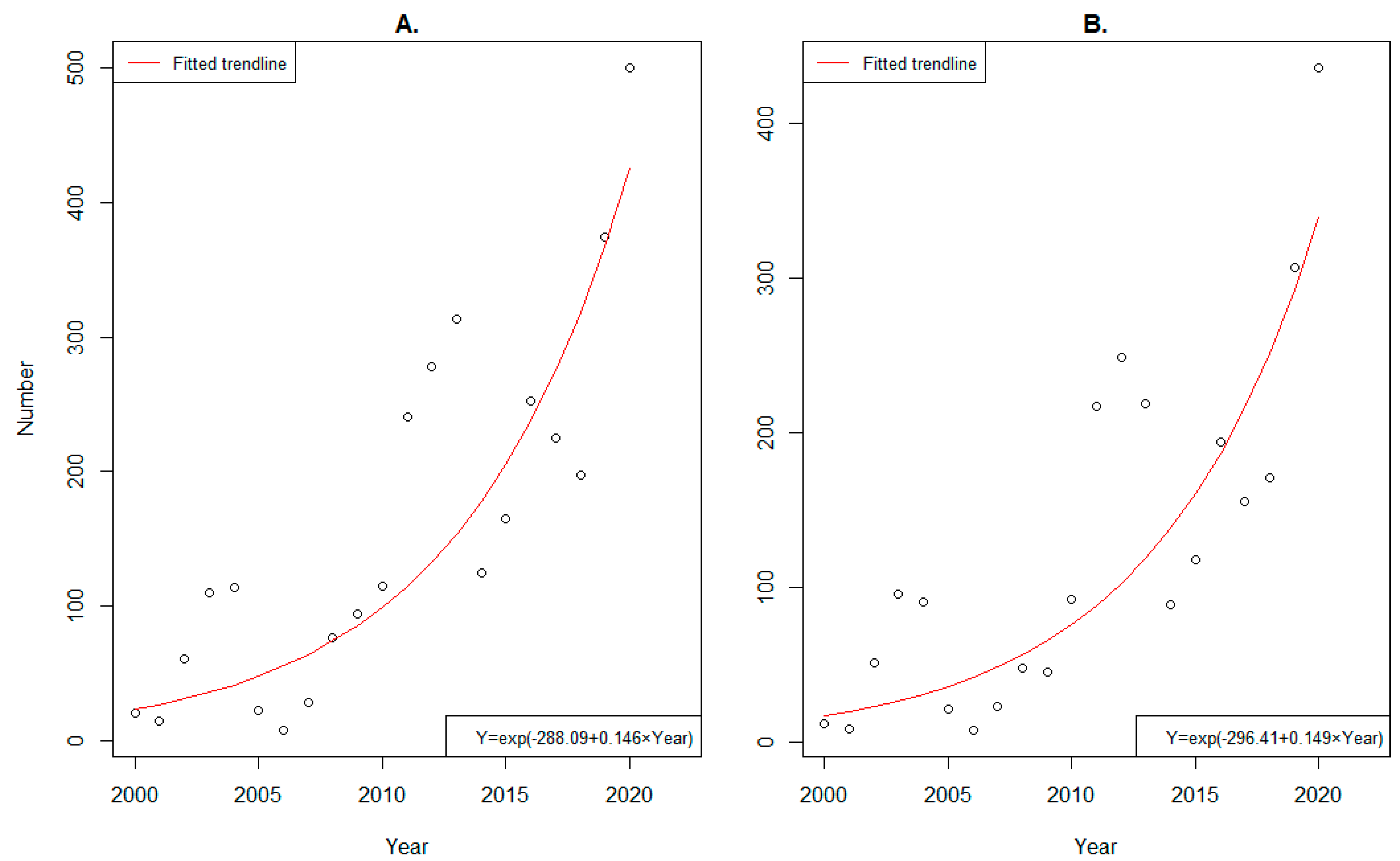
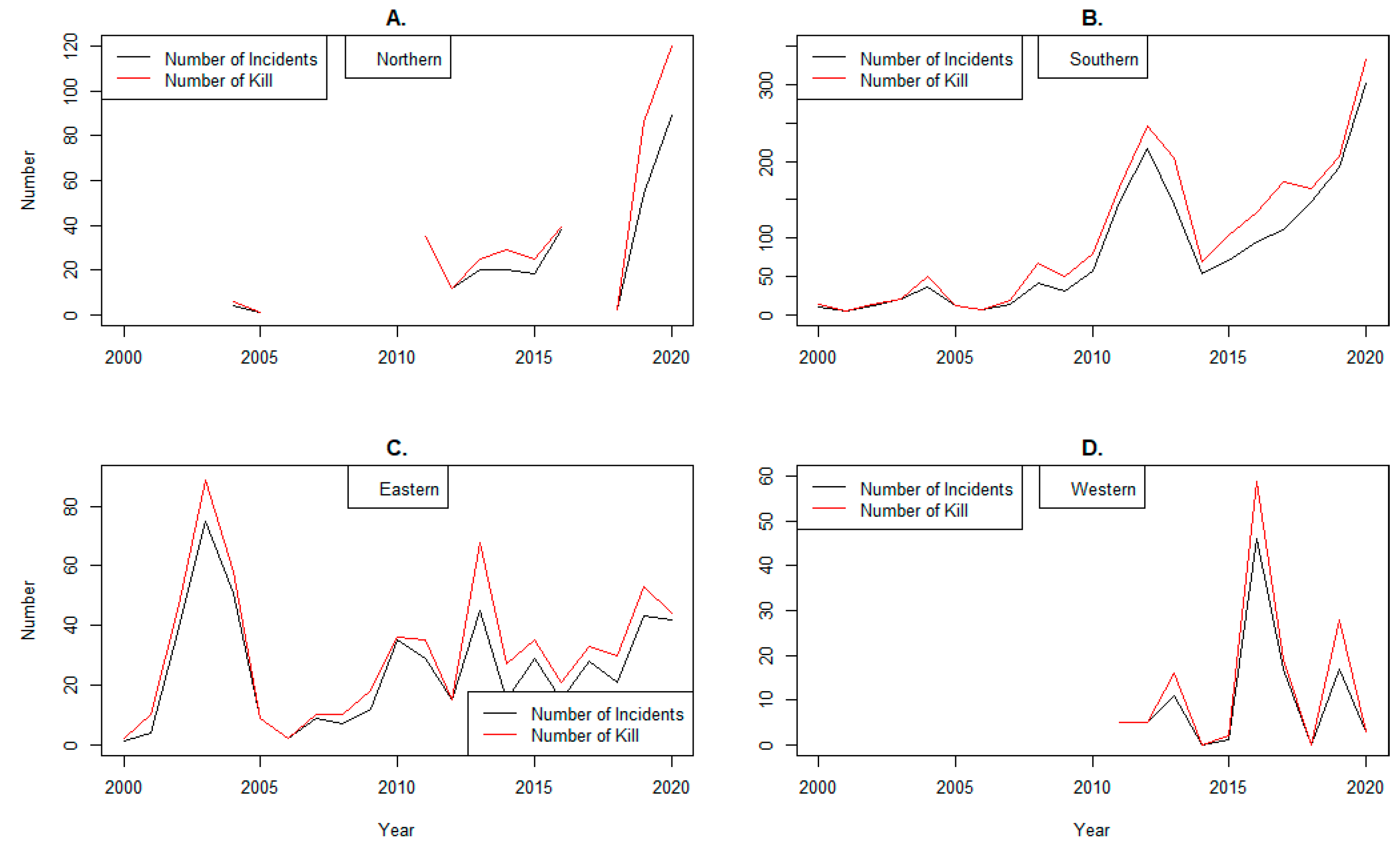
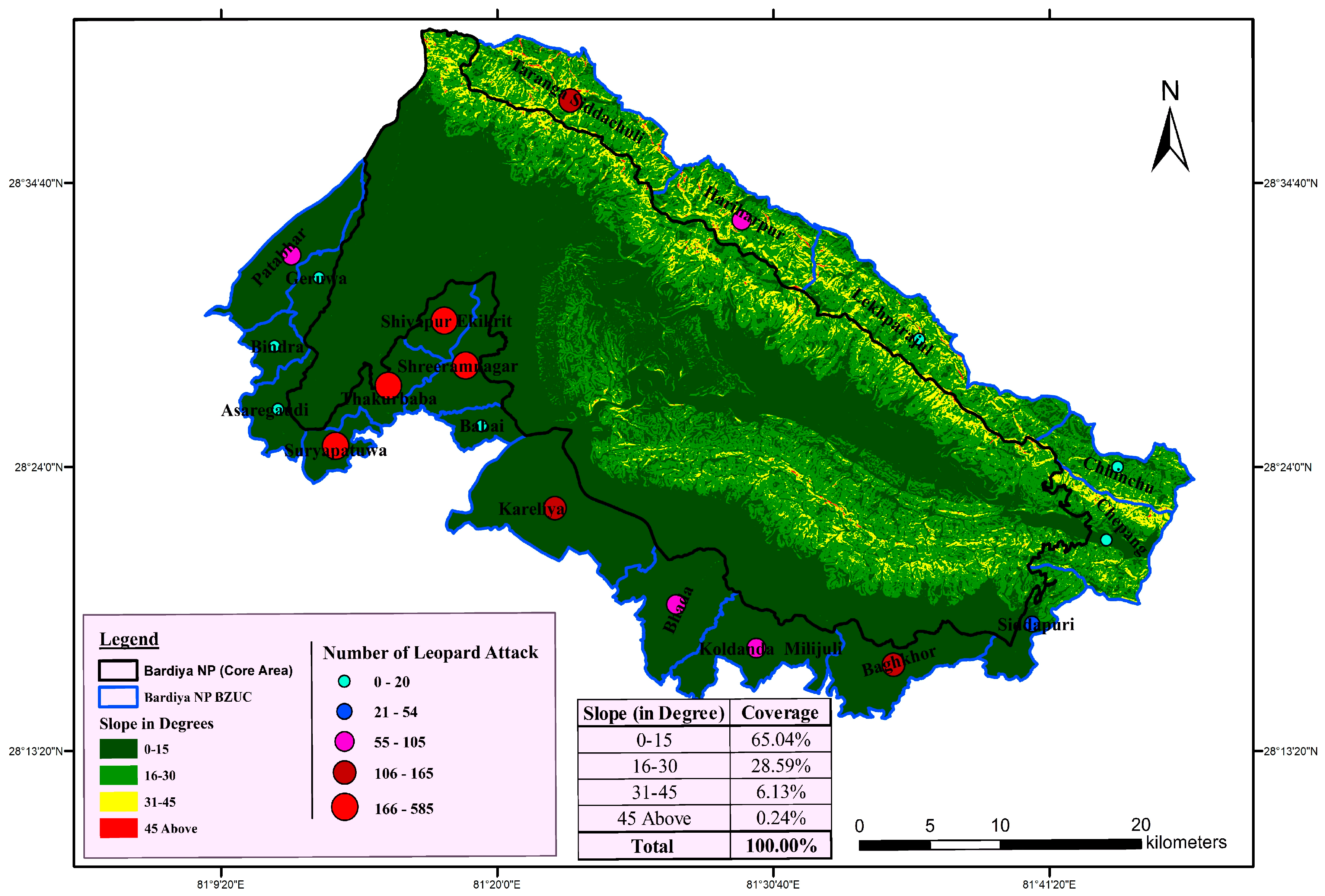

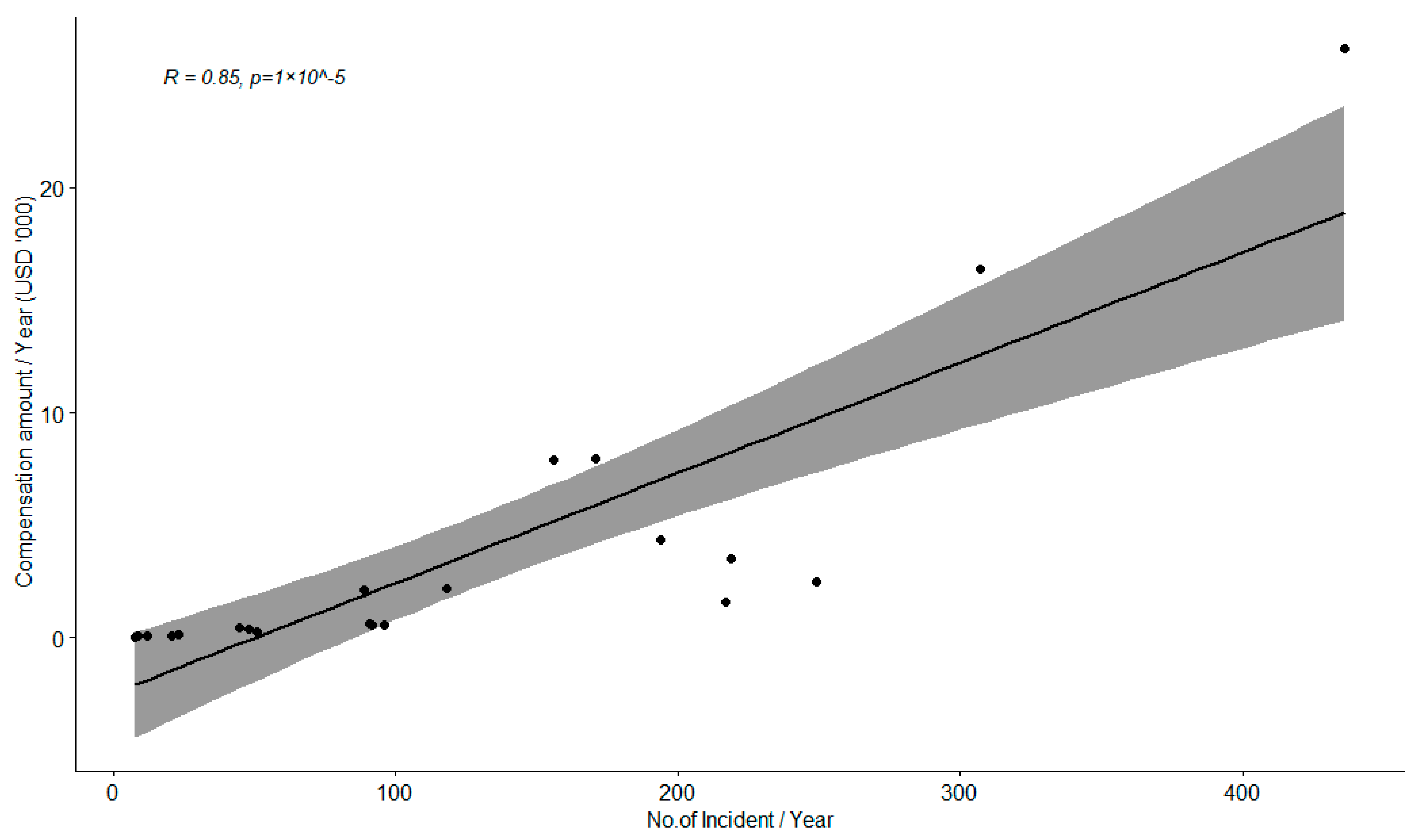
| Cluster | Attack Number (%) | Predation Number (%) | Average Predation Per Year |
|---|---|---|---|
| Eastern | 526 (19.83) | 652 (19.55) | 31.05 |
| Northern | 296 (11.16) | 411 (12.32) | 19.57 |
| Southern | 1725 (65.05) | 2135 (64.02) | 101.67 |
| Western | 105 (3.96) | 137 (4.11) | 6.52 |
| Total | 2652 (100) | 3335 (100) | 158.81 |
Disclaimer/Publisher’s Note: The statements, opinions and data contained in all publications are solely those of the individual author(s) and contributor(s) and not of MDPI and/or the editor(s). MDPI and/or the editor(s) disclaim responsibility for any injury to people or property resulting from any ideas, methods, instructions or products referred to in the content. |
© 2023 by the authors. Licensee MDPI, Basel, Switzerland. This article is an open access article distributed under the terms and conditions of the Creative Commons Attribution (CC BY) license (https://creativecommons.org/licenses/by/4.0/).
Share and Cite
Dhakal, S.; Rimal, S.; Paudel, P.; Shrestha, A. Spatio-Temporal Patterns of Livestock Predation by Leopards in Bardia National Park, Nepal. Land 2023, 12, 1156. https://doi.org/10.3390/land12061156
Dhakal S, Rimal S, Paudel P, Shrestha A. Spatio-Temporal Patterns of Livestock Predation by Leopards in Bardia National Park, Nepal. Land. 2023; 12(6):1156. https://doi.org/10.3390/land12061156
Chicago/Turabian StyleDhakal, Sandhya, Simant Rimal, Prashant Paudel, and Anil Shrestha. 2023. "Spatio-Temporal Patterns of Livestock Predation by Leopards in Bardia National Park, Nepal" Land 12, no. 6: 1156. https://doi.org/10.3390/land12061156
APA StyleDhakal, S., Rimal, S., Paudel, P., & Shrestha, A. (2023). Spatio-Temporal Patterns of Livestock Predation by Leopards in Bardia National Park, Nepal. Land, 12(6), 1156. https://doi.org/10.3390/land12061156







